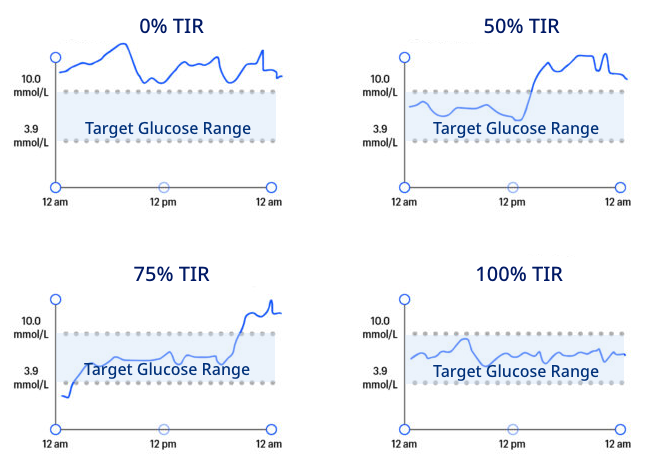
A1C and time in range: Getting the big picture of your diabetes

There are different types of blood glucose (sugar) measurements that can tell you different things about your diabetes.
Two of the main measurements are A1C and time in range. They can both help make sure you’re successfully managing your diabetes—but what’s the difference, and why should you care?
A1C is a reflection of your average blood glucose over the last 2-3 months. It can tell you how well you're managing your blood glucose over time.
Time in range (TIR) helps you understand the ups and downs of your blood glucose levels over the course of a day. It’s a percentage that tells you the amount of time you spend in your target blood glucose range versus the amount of time you’ve been high or low.
Together, both A1C and TIR provide a more detailed view of how your diabetes management is going.
How A1C is measured
The A1C test measures how much glucose is in your red blood cells. The higher the percentage, the higher your blood glucose levels have been for the last few months. Most people will aim for an A1C of less than 7%, but this can vary depending on your age and other factors. Talk to your health care professional about a goal that will work for you.
A1C = Average Blood Sugar Levels for the Past 2-3 Months
| A1C % | ESTIMATE AVERAGE GLUCOSE (mg/dL) |
|---|---|
| 10 | 240 |
| 9 | 212 |
| 8 | 183 |
| 7* | 154 |
| 6 | 126 |
*The American Diabetes Association (ADA) recommends a goal less than 7% for most people.
You should have your A1C tested by your health care professional 2 to 4 times a year—2 times if you are meeting your A1C goal, and 4 times if you are not meeting your goal or if your treatment has changed.
How time in range is measured
TIR is measured with a device called a Continuous Glucose Monitor (CGM). This device measures the fluid between your cells, called interstitial fluid. The CGM then sends you information about your current glucose levels and any changes over a few hours or days.
For most people, the recommended TIR is 70%. This means spending about 17 hours a day in your target range, without going too low or too high.
Example Time in Range Readings

For illustrative purposes only. 100% TIR is not a typical reading or a commonly recommended goal.
Why is A1C important?
A1C paints a broad picture of your diabetes. Getting your A1C tested can help confirm that your daily glucose checks are accurate. It can also show you how healthy choices can make a difference over time.
A1C is useful for predicting and preventing complications. If A1C is higher than 7%, there is higher risk for kidney disease, eye disease, and other complications.
Why is time in range important?
TIR can help you understand how food and activity impact your blood glucose on a daily basis. Plus, the more time you spend in range, the less likely you are to develop certain complications.
In the chart below, you can see that the more time you spend in range, the lower your A1C typically is. Plus, the higher your A1C is to start, the more increasing your TIR can help to lower your A1C.
Estimated A1C Based on Your TIR Level
| TIME IN RANGE | 40% | 50% | 60% | 70% | 80% | 90% |
|---|---|---|---|---|---|---|
| A1C | 9.0% | 8.3% | 7.5% | 6.7% | 5.9% | 5.1% |
*Most people aim for a 70% TIR, which strongly correlates with the ADA recommendation of less than a 7% A1C for most people.
Health care professionals can also use time in range to help you make a better plan for managing your diabetes. By knowing your daily highs and lows, your health care professional can make sure to avoid prescribing medications that will lower your blood glucose too much or too little—even if that’s what would be recommended based on your A1C level alone.
At the end of the day, knowledge is power.
The more you know about your blood glucose levels, the better you and your health care professional can understand and treat your diabetes. You can read more about blood glucose maintenance on the Staying on Track page.


